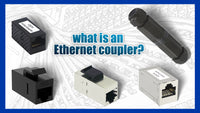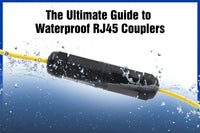Contents
The requirement for industrial network installation usually differs from that for small home and office networks. An often overlooked but important thing for network devices and accessories is the Ingress Protection Rating (IP rating). The IP rating of a network hardware or accessory determines whether it can survive in harsh environments. What is IP rating in networks? Does it matter for network products? What does the number mean in IP rating? We’ll delve into everything about IP ratings in this article.
What is IP Rating?
For users and customers who want to seek clarity on their network devices’ resilience in specific environment, the term “waterproof” or “dustproof” can be somewhat ambiguous. Users cannot totally understand to what extent their devices can resist water, dust, and solid objects. To provide a more specific and detailed explanation, the International Electrotechnical Commission (IEC) defines IP rating under the international standard.
The IP rating, short for Ingress Protection, follows a two-digit grading system used for electrical products’ enclosures. This system allows users to understand better of the item’s resistance to dust, dirt, and moisture.
But what the digits in the IP code signify? Each digit in an IP rating tells the item’s resistant level and we’ll see further in this blog.
An IP rating is typically composed of two digits followed by a supplementary letter. The letter is optional and often indicates the special material and testing scenarios. But the most common form of an IP rating is IPXX, such as IP55 and IP65.
The first digit can be a number ranging from 0 to 6, and the second digit is a number between 0-8. These numbers have different meanings. To unravel the specifics, refer to the IP Rating chart below.
The first number indicates protection from dust:
|
IP
|
First Digit
|
Protection From Foreign Objects
|
|
0
|
No protection from foreign objects or any physical contacts
|
|
|
1
|
Protection from foreign objects larger than 50 mm (such as hands)
|
|
|
2
|
Protection from foreign objects larger than 12 mm (such as fingers)
|
|
|
3
|
Protected against objects over 2.5 mm (such as tools)
|
|
|
4
|
Protected from anything larger larger than 1 mm (such as thin wires)
|
|
|
5
|
Dustproof, but some dust can pass through
|
|
|
6
|
Full protection from dust and any other particulates
|
The second number indicates protection from moisture:
|
Second Digit |
Protection From Moisture |
|
0 |
No protection |
|
1 |
Protected from water drops falling vertically |
|
2 |
Protected against water drops up to 15 degree from vertical |
|
3 |
Protection from water sprays up to 60 degree from vertical |
|
4 |
Protected from water splashing from any directions |
|
5 |
Protected against sustained, low-pressure water from any directions |
|
6 |
Protected from high-pressure, heavey water jets |
|
7 |
Protection from temporary water immersion at a depth ranging from 15 cm to 1 meter for up to 30 minutes |
|
8 |
Protection from water immersion at a depth more than 1 meters |
IP Rating vs NEMA Rating
NEMA rating is the preferred standard in the United States, and IP rating can be more popular in Europe. But they are both used to describe the level of an enclosure’s resistance to external environment. IP rating and NEMA rating use different parameters, so they cannot be converted. You have already known IP rating in the below content and we’ll not further discuss it. Let’s see the NEMA rating chart for more information:
NEMA rating has 10 different rates, and they have different meanings:
NEMA 1: Intended for indoor general uses
NEMA 2: Drip proof for indoor uses
NEMA 3: Protection against dust, rain, and ice (indoor&outdoor uses)
NEMA 3R: Protected from rain and sleet (outdoor uses)
NEMA 3S: Dust tight, rain tight, and sleet tight (outdoors)
NEMA 4: Water, dust, and sleet resistance for both outdoors and indoors
NEMA 4X: Water, dust, and sleet resistance and protection from corrosion
NEMA 5: Indoor protection against dust and water dripping
NEMA 6: Dust, water, and ice resistance, occasional water immersion
NEMA 6P: The same as NEMA 6 but can be submerged in water longer
NEMA 12: Protection from dripping and dust in industrial indoor uses
NEMA 12K: Protection from dripping and dust with knockouts
NEMA 13: Dust and oil tight for indoor uses only
IP Rating in Network
IP rating is an essential factor in industrial and outdoor network installation. For example, it plays an important role in keeping the optimal performance of devices such as industrial switches and RJ45 connectors. Industrial switches are generally exposed to environment full of dust, moisture, ice, water immersion, chemical exposure or other foreign objects, and the IP rating makes the switch still perform well in these conditions.
RJ45 connectors or couplers play an essential part in both outdoor and indoor network installation. As is known to all, extreme weather often happens outside especially in some areas, so the IP-rated housing should be considered to keep the capability of connectors and couplers.

Common IP Ratings in Network
- IP67: IP67 enclosure can resist all dust and protects from temporary water immersion. This is a common rating for network hardware and accessories on the market and is often marked as “waterproof”.
- IP68: IP68 products can be submerged in the water at a depth more than 1 meter and these items often come with caps or covers for great seal. For example, some waterproof RJ45 couplers use IP68 rating.
Conclusion
The IP rating can determine the service life and reliability of network products in extreme environments.Understanding IP ratings ensures that you can make informed decisions about deploying electronic devices in specific environments, considering factors like exposure to dust, moisture, or water. Hope this blog can help you if you have any doubt about IP rating.
For more information on this topic, you can keep up on our blogs. While VCELINK offers general and basic information for our customers and other visitors to the website, it’s not professional advice.






Be the first one to comment.
Leave a comment